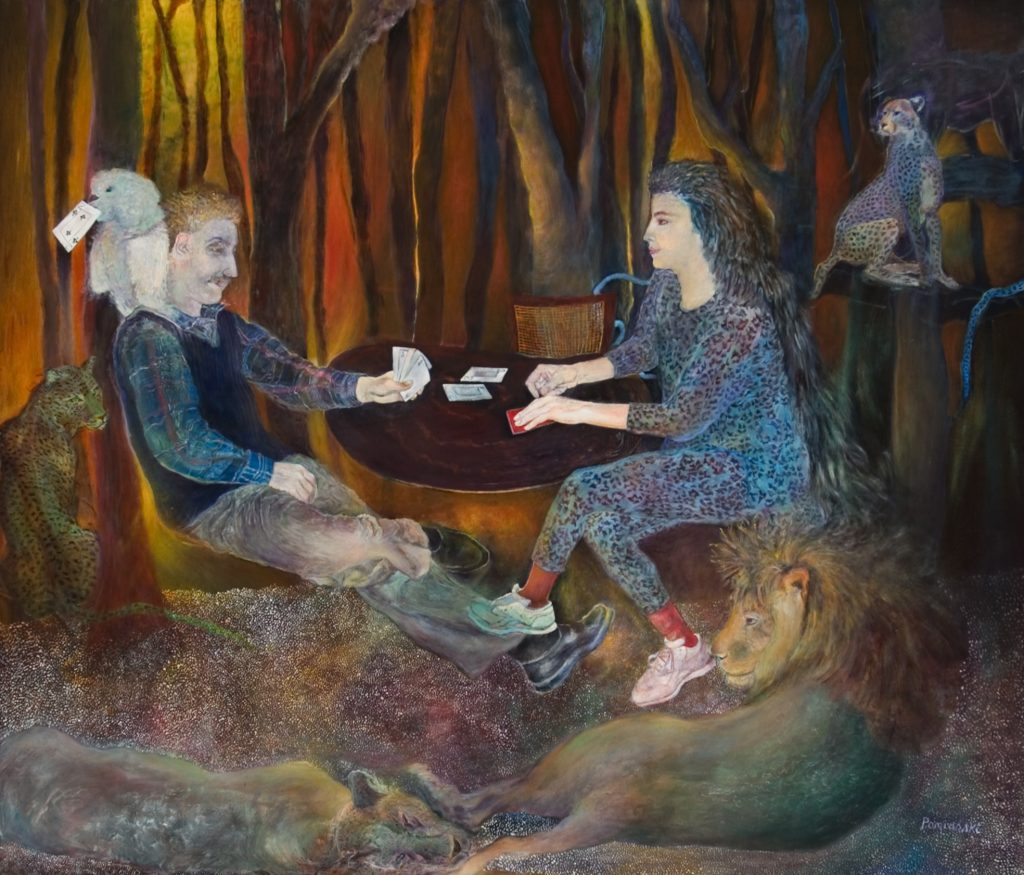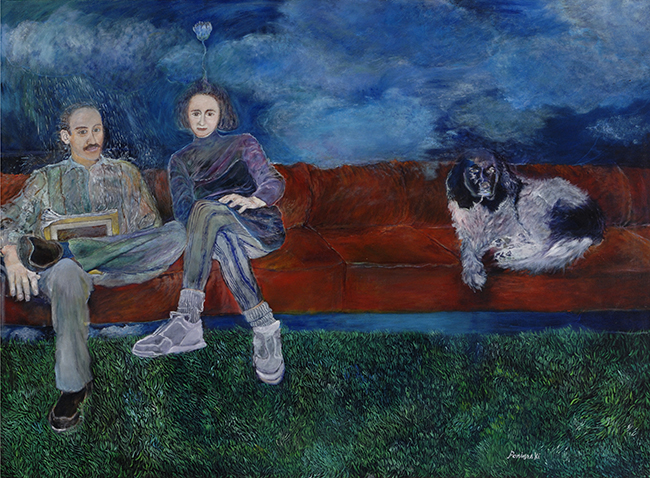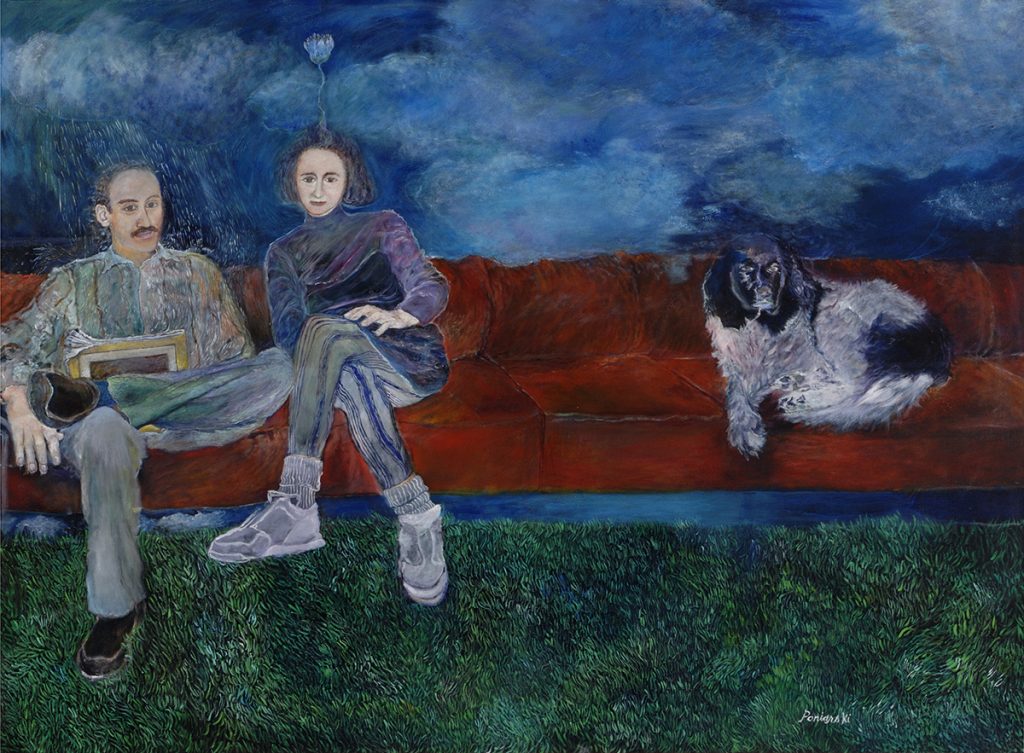Ruth Poniarski’s creative path began not with a brush, but with the discipline of architecture. In 1982, she earned her Bachelor of Architecture from Pratt Institute, and for a decade she worked in the construction field. Yet architecture, with its rigid lines and calculations, was only the beginning of her exploration of space, form, and meaning. In 1988, she turned to painting. This shift opened a different kind of structure, one governed not by blueprints but by imagination and inquiry.
Her work blends surreal imagery with echoes of myths, literature, and philosophy. In her paintings, familiar cultural archetypes collide with abstract forms and dreamlike scenes. Poniarski creates spaces where personal and universal stories coexist. Her brushwork pushes the viewer into unfamiliar territory—where the symbolic and the subconscious meet. Each canvas becomes less about representing the external world and more about revealing the inner landscapes of thought, memory, and time.
The Work: Atlas and Eve

Atlas and Eve presents a vision of departure, struggle, and resilience. At its heart is the tension between two enduring figures—Eve, long cast as the transgressor, and Atlas, the eternal bearer of the heavens. Here, Eve is not framed only by sin or shame. She is described as “the villain of truth,” a phrase that complicates her role. She conquers a solitary leaf, forging it into a branch—a gesture of survival and creation.
Atlas, meanwhile, holds the heavens from the earth, straining under the weight of universal order. Around them swirls a poetic meditation on time and energy: oceans of thought, atoms, spores, and systemic growth. The imagery ties the biblical expulsion from Eden to the emergence of civilization. Outside paradise, there is wilderness and hardship, but also cultivation and nation-building.
The painting challenges received ideas of innocence and guilt. Eve is not merely cast out—she is a force of continuity, a bearer of future generations. Her struggle parallels Atlas’s eternal burden. Both figures embody endurance, but where Atlas shoulders the cosmos, Eve seeds the earth with roots. The work situates myth in dialogue with human perseverance.
The Work: Who’s Game #2 Dawn

This painting carries a different tempo. Who’s Game #2 Dawn moves with the rhythms of time and waking. The narrative begins at daybreak. The sun dusts the horizon. Creatures stir. Dreams linger but dissolve into the “game” of existence.
The title frames life as a game—ongoing, precarious, yet filled with possibility. The dawn is more than a natural event. It marks the passage across thresholds: sleep to waking, past to present, hesitation to action. The figures struggle out of their dreams, but the promise of fate remains. Time is a border they cross daily, each crossing an act of renewal.
What makes this piece resonate is its suggestion of self-recognition. Before silence breaks, before the world imposes its noise, there is a return to oneself. The painting captures that fragile moment when identity regathers at the edge of morning. It portrays existence not as static but as constantly rehearsed and reawakened.
The Work: Tele-Vision, The Endless Couch

In Tele-Vision, The Endless Couch, Poniarski takes on the modern ritual of watching, recording, and being recorded. The work is layered with references to history, time, and media. The couch is endless—suggesting both comfort and paralysis.
Through the camera’s eye, history unfolds. Events are revealed and interpreted, yet never free of distortion. The painting speaks of tenacity and separation from time, as if modern spectatorship removes us from direct experience. What we see is filtered through the screen, then replayed, then remembered differently.
Yet amid this, there is also creation. Seeds of ideas transform into new worlds, born from “the devoted waters of another.” This phrase suggests that even passive watching holds the potential for transformation. The endless couch is not just a trap. It is also a place where imagination might stir, where visions can take shape beyond the screen.
Closing Thoughts
Ruth Poniarski’s paintings balance mythic scale with intimate reflection. Atlas and Eve wrestles with origin stories, reframing guilt as endurance. Who’s Game #2 Dawn follows the renewal of consciousness at daybreak. Tele-Vision, The Endless Couch interrogates the role of spectatorship in shaping history and thought.
Together, these works reveal an artist deeply attuned to the intersection of narrative and image. Poniarski uses surrealism not to escape reality but to probe it. She takes cultural archetypes and everyday rituals, then stretches them into timeless meditations. Her background in architecture shows in the structural logic of her canvases, but what dominates is the imagination—restless, questioning, and resolutely personal.
Her art asks viewers to look inward as much as outward, to consider how myth, time, and modernity entwine. In this, Poniarski continues to cultivate a body of work that both honors tradition and reshapes it for contemporary reflection.

